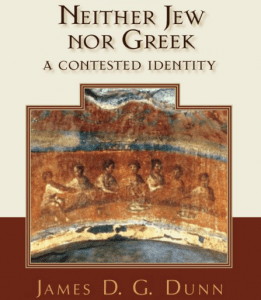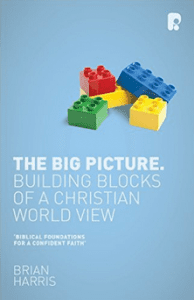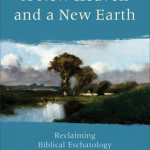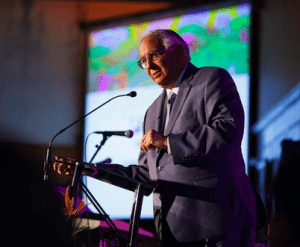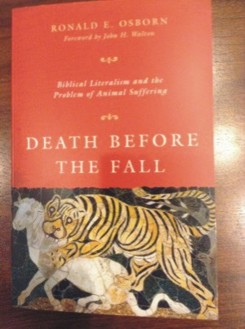 In the previous two posts (here and here) we looked with Ronald Osborn (Death Before the Fall) at the cosmic theodicy of C.S. Lewis and the creation narrative in the book of Job (a passage we too often overlook to our own detriment). Today we turn to the perspective that I see as the central issue in this entire discussion – Christ centered creation.
In the previous two posts (here and here) we looked with Ronald Osborn (Death Before the Fall) at the cosmic theodicy of C.S. Lewis and the creation narrative in the book of Job (a passage we too often overlook to our own detriment). Today we turn to the perspective that I see as the central issue in this entire discussion – Christ centered creation.
But Christianity – the faith whose central event is the brutal execution of the God-forsaken God on a Roman cross – greatly complicates and deepens our understanding of the divine response to suffering, whether of humans or animals. It also denies us any stoical pact with the cruelties of death as divinely fated necessity of life. Death is the final enemy. (p. 158)
This central focus has (or should have) a profound influence on the perspective we take of creation and the nature of creation. There is, quite frankly, nothing christological in the typical literalist reading of Genesis. Christ is the subsequent solution to a problem … a problem of our making although many will also point to God’s foreknowledge and/or predestination in the discussion. But this is not the universal Christian view. Turning to the ancient church fathers Osborn puts on the table the view that God’s purpose in creation always included the incarnation as a necessary part of bringing humans into union with God.
The creation was never a static golden age but always an unfolding story with an eschatalogical horizon. And the divine love has always willed that the journey of creation and the pilgrimage of humanity should end in our final adoption as coheirs of God’s kingdom and “partakers of the divine nature.” The destiny of humankind is not simply a recapitulation or recurrence, paradise lost, paradise restored. Rather, the end is greater than the beginning – and was always meant to be so through the mystery of the incarnation. (p. 159)
This view causes consternation for some Christians. The linear creation, fall, redemption story line is deeply connected with a popular view of atonement. After a bit of discussion of atonement theory, Osborn suggests that perhaps the weakness lies with the monotone view of atonement as penal substitution. We need a bigger and broader picture including the ancient understanding of ransom and Christus Victor in the mix (Scot’s A Community Called Atonement is a good resource here).
 The importance of kenosis. Beyond the mere statement of atonement, though, there is the power and the significance of kenosis, κενόω, – the self-emptying of Christ. Paul tells the Philippians … probably quoting an even older christological hymn of the church:
The importance of kenosis. Beyond the mere statement of atonement, though, there is the power and the significance of kenosis, κενόω, – the self-emptying of Christ. Paul tells the Philippians … probably quoting an even older christological hymn of the church:
Have this attitude in yourselves which was also in Christ Jesus, who, although He existed in the form of God, did not regard equality with God a thing to be grasped, but emptied Himself, taking the form of a bond-servant, and being made in the likeness of men. Being found in appearance as a man, He humbled Himself by becoming obedient to the point of death, even death on a cross. (Phil. 2, NASB)
The character and governance of God is revealed in Jesus as the crucified savior, God’s Messiah. This isn’t part of the machinations of meticulous manipulation, but the response and plan of a God who is in relationship with his creation, a creation prepared for his purposes with a freedom of will the result of divine will.
Whatever its difficulties, the only position that makes any moral, religious, or rational sense of human moral evil to my mind is the one that declares that the divine will wills human free will, and is both powerful enough and self-giving enough to create beings with the capacity to make meaningful, self-defining choices that are morally and spiritually significant. (p. 161)
This position is also, to my mind, the only one that makes any sense at all of the biblical narrative from Genesis to revelation. The text we have is characterized by the response of God to faithfulness and faithlessness of his people. He is in relationship with people who have the freedom to follow or to turn away. We can cherry pick selected verses that support meticulous sovereignty, but can maintain that position only by rationalizing away the vast (vast!) majority of the text. God’s control is an open-handed control.
This God willed freedom extends (and here Osborn quotes John Polkinghorne) to freedom in the very nature of creation, a freedom that includes quantum uncertainty, plate tectonics, weather, and evolution. Osborn brings in a study by Dietrich Bonhoeffer (Creation and Fall Temptation: Two Biblical Studies) “The Creator wills that his creation itself should affirm and continue his work, he wills that created things should live and create further life.” This God-willed freedom is in harmony with the nature of God and with the person of Christ in the Gospels.
[A] kenotic picture of the Creator insists that God’s creative might and sovereign rule are always expressed in harmony with his character as revealed in the historical person of Jesus, whose way was one of cosuffering humility, nonviolent self-limitation and liberal self-donation. (p. 162)
And Adam? There is more to a Christ-centered view of creation than the fall of Adam and Eve. It is Christ, not Adam who is the first true human.
Some have insisted that without a historical Adam the life, death, and resurrection of the historical Jesus would be devoid of meaning. But this claim amounts to a denial (even if unintentionally so) of the centrality of Christ; for it gives the fallen Adam of Genesis an interpretative primacy over the Jesus of history that Paul and the Gospel writers do not allow. For disciples of Christ, it is only in Christ that the ancient story of human origins and destiny can be rightly understood – not the other way around. We do not read the story of Christ “Adamically.” We reread the story of Adam christologically in the light of the second Adam who is also the first Adam, the first fully human being of whom the ancient story is only a type, a dim shadow and longing, a “figure of him that was to come” (Rom 5:14). (p. 164)
Whether or not Adam existed as a unique historical individual is really quite secondary to the biblical narrative. Adam was not the culmination of some perfect creation. Rather, Osborn suggests that we should look to Christ in his life, self-emptying death as the culmination of creation. The cry “it is finished” carries a profoundly deep meaning … only with this is the creation of the world finally complete. The rest in the tomb is the sabbath rest, in many respects the first sabbath, followed with resurrection by new creation. We shouldn’t take this too far as we still live in anticipation of the age to come, where death is fully and completely vanquished.
But the point remains. Christ isn’t the solution to a problem of our (or Adam’s) making. Before the beginning of the world he was – the firstborn of all creation. We need a Christ centered view of creation.
I agree with most of what Osborn has to say in this chapter, and consider it one of the most important points we can make in the entire discussion. But perhaps you disagree.
What does it mean to have a Christ centered view of creation?
Does this a necessary feature of a Christian view of creation?
If you wish to contact me directly you may do so at rjs4mail [at] att.net.
If interested you can subscribe to a full text feed of my posts at Musings on Science and Theology.


